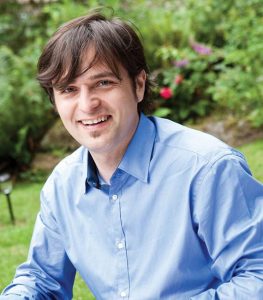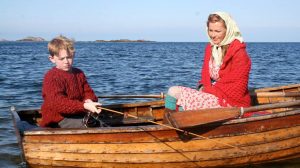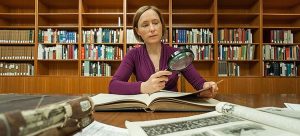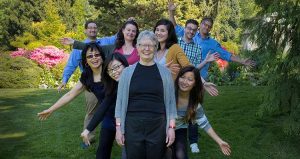Meet BA ’05 grad Michelle Kuen: Pursuing a career in visual arts
Michelle graduated from the University of British Columbia in 2005 with a Bachelor of Fine Arts in Visual Art and English Literature. Now devoted to her artistic practice full-time, she divides her time between her personal artistic pursuit and the commercial sector.
Meet BA ’04 grad Myomi Chu: International design
A jet-setting international traveler with an eye for graphic design. Fresh off the UBC boat in 2004, Myomi planned to take a couple months off to travel to the Philippines, her country of birth, to visit family and friends. Two months became half a year, and before she knew it, she traveled to Hong Kong, […]
Meet Katrina Lo: English research, eh?
By Katie Fedosenko Undergrad investigates Canadian lingo alongside professors Anyone who has ever wrestled with an American spell-check knows very well that Canadian English is different. We have extra ‘u’s in ‘colour’ and ‘humour’, we’re travellers, not travelers, and we have the dignity to end our alphabet with a zed, as the Queen intended. But […]
Meet BA ’06 Cait McKinney: Uncovering subversive and politically charged historical valentines
Sending valentines may not be the most obvious method of political campaigning, but it was one of the ideas adopted by the Congressional Union for Woman Suffrage in their campaign for the vote.
Cait McKinney (BA English Honours, ’06) came across these witty and pointedly political historical records as part of a research project completed for the English honours seminar she took in her final semester of study at UBC with Professor Mary Chapman.
Political Persuasion
The valentine cards, sent to anti-suffrage American congressmen and President Thomas Woodrow Wilson on Valentine’s Day 1916, are personally tailored messages that used tongue-in-cheek rhymes and cartoons to advocate for suffrage. McKinney’s project and website includes reproductions of the previously unpublished valentines accompanied by critical annotations and an essay.
Working With Experts
To compile it, McKinney worked closely with the Sewall-Belmont House and Museum in Washington, DC, dedicated to the evolving role of women and their contributions to society through the continuing story of women’s pursuit for equality. Museum staff helped McKinney track down some of the valentines, and also scanned these for the project. The Sewall-Belmont House recently featured McKinney’s website in their online newsletter, a publication that reaches more than 2,500 readers.
“I wanted the students to experience, even vicariously, the thrill I have when I go to the archives and snoop around and find things,” says Professor Chapman, who taught the research-based seminar on American suffrage print culture. Prior to teaching the course, Chapman had conducted research in Sewall-Belmont House archives.
Primary Research A Great Learning Opportunity
“Most of the research that we get to do as undergrads is a new take on things that have already been done,” adds McKinney, who welcomed the opportunity to tackle research involving primary sources and then present her findings using the web. “Dr. Chapman wanted us to explore how we could use the Internet as a tool for letting other people gain access to either research that has not gotten a lot of attention, or is in danger of effectively going out of print,” McKinney says. “That’s particularly a big issue when you’re talking about women’s history because sadly there’s still not a lot of money devoted to publishing this kind of stuff,” she adds.
When McKinney first signed up for the honours seminar, she thought studying the suffrage movement would be a drag. Her original research gave her the chance to find an angle that interested her — the valentines and their representations of female sexuality. “It’s an example of how suffragists were really cunning in the way that they formed their arguments and eventually managed to win the vote by appealing to men on their own terms,” said McKinney. “They’re playing with the male idea of woman-as-object to be sexually conquered —they’re throwing it back in their critics’ faces. That’s why these valentines are so subversive and so effective: because they take the argument that was always thrown at feminists during that time period — that women were to be controlled and used by men and were not suited to voting — and make it their own.
More about McKinney
McKinney was a well-known undergraduate at UBC — she edited the AMS Insider, the student planner that is distributed to students every year. She also worked at the wellness centre as a peer educator and was active with the UBC Film Society as advertising manager and social coordinator. While she has plans to get back to school to pursue graduate studies in cultural theory, in the long term, she plans to continue doing what she’s doing now — writing with a youth focus. She currently works as a writer and researcher for Free The Children in Toronto, an international charity that seeks to raise awareness of global poverty amongst youth, and empower young people to realize that they can have an impact on the world.
By Alexandra Chu, BA ’07 in English Literature and a minor in History.
Meet BA ’06 Alexandra Chu: The possibilities of Arts Co-op
The artist’s nickname is “Crabby Tanabe,” and despite his daunting reputation, Alexandra Chu wanted to interview him.
When Takao Tanabe finally called, the 80-year-old Governor General award-winning landscape artist wanted to know exactly what the UBC student knew about visual arts to write an article about it.
Chu, who graduated in May 2006 with a BA in English literature and minor in history, admits she didn’t know much, but she loved the artist’s work and, more importantly, she could write.
Chu considered her profile on Tanabe, which appeared in Ricepaper, the Vancouver-based magazine focusing on Asian Canadian arts and culture, as one of her favourites.
Other profiles she has written include Whistler’s own National Alpine ski racer and Olympic hopeful, Britt Janyk, and illustrator Marcos Chin, the artist behind the “look” of online dating giant, Lavalife.
“Anyone who does reporting, you feel so proud when you have your name out there,” Chu says. “You can google yourself and things come up.”
You could say Chu is building her future one word at time. Literally.
Chu was the recipient of the first-ever UBC Arts Co-op Student of the Year Award, a recognition she received after spending a term writing for FrontCounter BC, a one-stop shop for natural resource businesses wishing to obtain required paperwork.
From the pilot office in Kamloops, BC, Chu assisted in setting up nine other locations throughout the province. She developed content and layout for the agency’s website, created marketing brochures, and produced an online newsletter that caught the eye of an assistant Deputy Minister.
Impressed by the quality and language of Chu’s work, the agency continued publishing the newsletter past its scheduled end date of December 2006.
“She’s a good example of a student who really understood that career development is not something that happens overnight,” says Julie Walchli, founding director of the UBC Arts Co-op Education Program.
“So step-by-step, co-op term by co-op term, and freelance writing assignment by freelance writing assignment, she built a very impressive portfolio and is now graduating with a lot of experience under her belt and a lot of contacts.”
Chu got her big break at the Whistler Museum and Archives, her first co-op work term in 2004. Asked to do an independent research project to contribute to the museum’s records, Chu profiled the movers and shakers of the famed mountain resort community.
“I’d never interviewed, I didn’t know how it would go. I didn’t know if I’d follow the questions I’d set out, or if I’d talk freely,” Chu recalls.
“A few months later, the curator sent me an e-mail and she wanted to use parts of my project for a feature article that was on the cover of the news magazine The Pique for women’s history month.”
When the article appeared, the curator had written an introduction and a conclusion, but the rest was all Chu’s work. “And so that was my start,” she says.
From her first publication at Whistler to writing articles for the Faculty of Arts’ newsletter and website, to being the visual arts editor at Ricepaper, to helping launch FrontCounter BC, the judging committee was impressed, says Walchli.
“A lot of students in Arts want to be journalists, or professional writers in some way, and often it’s hard for them to know how to get started in that career,” Walchli says. “And Alexandra knew that each of her co-op terms and the things she did outside of co-op were building blocks to that ultimate goal.”
Chu’s spot on the Dean’s List during every term at UBC and her onerous role as the editor of the UBC Arts Co-op student newsletter were a some of the many reasons that set her apart from other award candidates, adds Walchli.
From having career goals of wanting to write for a living to interviewing prominent people, Chu has built a hefty portfolio.
“It’s been really exciting because [Ricepaper] is nationally published, and it’s nice to know that someone in Toronto might be reading your work,” says Chu of her feature articles.
Chu acknowledges she was intimidated by the prospect of interviewing Tanabe, but she was in for a surprise after his unexpected call, which produced a personal invitation to his retrospective exhibition.
“He was just so nice. He was the kindest person,” she recalls. “He talked — he was really candid. I love meeting people like that. And some articles, they just come. You just write them, they’re there.”
Today, Chu is the assistant director of marketing and client services at Canadian Education Centre Network, a non-profit company aiming to promote Canada as a study destination for international students. She is one of roughly 2,000 students graduating with an Arts degree this year.
Not bad for a girl who didn’t know what she wanted to do with her English degree. But after four co-op terms at UBC, Chu thinks of her degree as a valuable learning opportunity, helping her to develop her career.
“It’s been about finding what I could do with my English major,” she says.
“At first, with English literature, it seemed like there was not a lot to do,” recalls Chu. “But I think of my writing skills and my research skills as traits. And a lot of people don’t think of it that way, but I think of them as traits that I’ve developed because people commission me to write articles and pay me.”
Chu considers the network of contacts she has built to be invaluable.
“The people you meet are just as important as the jobs you do because you’ll meet people who will be really supportive, who will be references for you to get a career when you graduate, who will help you find other things you’re interested in,” Chu says.
“Like in Whistler, I was really interested in writing. They let me go with it. They helped me to make it something more than just a book in the museum that people may or may not look at.”
Chu, who spent the other co-op terms writing and researching for the Dean of Arts office, the Richmond Museum, and the Whistler Museum and Archives, credits her UBC degree for providing her with transferable skills.
“One of the things in Arts is thinking outside the box. You may not graduate with something like an accountant where you have a specific job, but you have these skills to do anything,” she adds.
“I have a wealth of experience working with children, working as a writer and reporter, working on websites, working with customers in museums, communicating through all sorts of avenues.”
By Bryan Zandberg (BA, 2006, in French and Spanish). Bryan is a former editor with The Ubyssey.
Meet Postdoctoral Fellow Stefan Dollinger: Putting English students in the lab for the Dictionary of Canadianisms
UBC Postdoctoral Fellow Stefan Dollinger is taking English students out of the classroom and placing them into the lab as he heads the revision of the Dictionary of Canadianisms.
The project will be the first of many to come out of the Canadian English Laboratory and aims to provide an updated version of the Dictionary of Canadianisms on Historical Principles (DCHP2). Published in 1967, the first edition was not consistently maintained, leaving it outdated. Dollinger hopes to update the Dictionary while adding new entries from the last 40 years.
The team behind the second version of the Dictionary of Canadianisms has already discovered several new “Canadianisms”, or words and phrases that are unique to Canadian English. There are even some examples of words that originated on the UBC campus.
They’ve found that the oldest citation of the word “creamo” dates back to a 1925 version of the Ubyssey newspaper. Similarly, the drink “Brown Cow” was traced back to a 1976 edition.
Dollinger, who is involved in many research projects with the Canadian English Laboratory, hopes for the success of the Dictionary to be widespread. He aims to make the Dictionary available to Canadian universities and libraries to ensure the general public has access.
The Canadian English Laboratory employs many volunteer and paid student workers, including third year English honours student Sam Chung, and fourth year English Language student Cicily Cooper.
“I’m a research assistant in the Canadian English Language Lab,” Cooper explained, “We ‘harvest’ citations from periodicals we get through huge databases and find words that are Canadianisms.”
“I’ve even found some from the 1700s and 1800s!” Chung said. “We enter the words into the Bank of Canadian English and that’s pretty much it.”
Chung and Cooper both got involved with the project after taking Dollinger’s English 229 class on Canadian English words. Students in the class were asked to research Canadian words for a project; those that did well were given the opportunity to volunteer or work with Dollinger in his lab. Dollinger tries to include some work with the Bank of Canadian English in most of his courses.
Cooper and Chung excelled in their positions and were given paid part-time positions for the summer.
In addition to working with the Dictionary, Chung and Cooper were able to present their research at the Multidisciplinary Undergraduate Research Conference (MURC) last year. They were part of a five person student research team that worked with Dollinger to create a presentation for the conference. Their panel was one of only two groups presenting research in English, which Chung thinks is a shame.
“People have a mentality that research is exclusively reserved for sciences,” Chung said, “MURC was predominantly Science students with the odd Arts students who were mostly from Psychology.”
“I really want to see more Arts students presenting!”
Chung cites Dollinger’s help in the MURC as invaluable, and is grateful for the close relationship they have developed.
“He taught me everything step by step; he’s really caring.” Chung said, “The thing about Professor Dollinger is that he uses students as instruments of research so you’re not just working under him, you’re working alongside him.”
“I’m very indebted to him,” Chung added.
Cooper enjoys being a part of something that hasn’t already been studied in a classroom.
“As an undergrad you rarely feel like you’re a part of something new and different,” Cooper explained. “That’s what’s cool about being in research. I’m finding things that haven’t been found before.”
“I think it’s helped me realize all the opportunities that are out there and feel less limited. Doing this research has made me see there’s more than I can imagine!”
By Meghan Roberts (BA 2008, English Literature and International Relations).
Meet BA ’00 Sarah Galashan: Aiming for the front page
Sarah Galashan had wanted to be a journalist since age 16, and after she gained experience volunteering and interning at various news stations, she realized she thrived off the adrenaline in the fast-paced news environment. Sarah graduated from UBC in 2000 with a BA in Canadian Studies.
Three UBC Arts alumni collaborate on film – A Shine of Rainbows
It’s a small world after all: Editor Alison Grace (BA ’71 Film) ,Screenwriter Dennis Foon (MFA ’75 Creative Writing), and Associate Producer John Bolton (BA ’99 Hon. English) collaborated on the recently released and award winning film A Shine of Rainbows. A UBC Arts degree can connect you with talented peers for years after you graduate and take you around the world; in this case, a film set in Ireland.
Meet Professor Mary Chapman: Pioneering American suffrage literature research
Associate Professor Mary Chapman won the 2006 Yasuo Sakakibara Prize from the American Studies Association for an essay on writer Sui Sin Far, believed to be the first Eurasian to publish in Canada and the United States.
The paper is part of a book-in-progress on American suffrage literature, and examines Far’s work during the Progressive Era, a period of reform from the 1890s through the 1920s that saw many Americans push for social justice, general equality, and public safety.
Separated from her two-year-old son for nearly a year, a Chinese mother sacrifices everything to get him back. After spending her life’s savings to hire a lawyer, the woman is reunited with her child. But he no longer remembers her, or their native tongue.
She can’t believe that the government would take away her child in what she thought would be “the land of the free.”
The story — entitled “In the Land of the Free” — was published in 1912 in Mrs. Spring Fragrance, a popular short story collection by Sui Sin Far, pen name of British-born writer Edith Maude Eaton (1865 – 1914).
The story collection reflects the struggles and joys in the daily lives of Chinese families in North America. Far, who lived in Montreal and later moved to San Francisco and Seattle, depicts the anguish of Chinese immigrants, and the suffering inflicted by discriminatory immigration laws.
Associate Professor Mary Chapman, who teaches in the Department of English, recently won the 2006 Yasuo Sakakibara Prize from the American Studies Association for an essay she wrote on the pioneering writer.
Chartered in 1951, the American Studies Association has more than 5,000 members, including teachers and other professionals, concerned with American culture.
Prof. Chapman’s paper is part of a book-in-progress on American suffrage literature, and examines Far’s work during the Progressive Era, a period of reform from the 1890s through the 1920s that saw many Americans push for social justice, general equality, and public safety.
Among other things, the progressive movement called for the humane treatment of mentally ill people, worked for the organization of unions, and gave citizen women in the United States the right to vote by 1920.
Prof. Chapman probes into Far’s awareness of the shortcomings of the Progressive Era and the exclusion of Chinese immigrants from fundamental rights.
“At the very same time that they were advocating greater access to government, and votes for women, they excluded the Chinese from immigrating,” Prof. Chapman says.
Born to a Chinese mother and a British father, Far began her career at The Montreal Star and wrote one of the first public statements in opposition to the Chinese Head Tax in Canada. She wrote numerous articles and stories, which appeared mainly in American newspapers and magazines.
Prof. Chapman has found new material through what she calls intense digging in Far’s life. After searching for works not included in “Mrs. Spring Fragrance,” she has found articles showcasing the writer’s interest in China’s efforts to change outdated laws.
The enfranchisement of women in a Chinese province in 1912, while progressives in the U.S. were still campaigning for women’s right to vote, exposed the limits of American efforts to reform, says Prof. Chapman.
“So all of a sudden, this culture, which even the most progressive-minded Americans had perceived as inferior and backward, had given their votes to women,” she says.
“Far was very supportive of the Chinese reform movement which had, as one of its goals, the enfranchisement of Chinese women,” she adds. “She took great delight in showing how liberated Chinese women were.”
Prof. Chapman believes it was clear to Far that the progressive movement had an exclusive agenda. The writer’s “In the Land of the Free” pinpoints just that.
The story simultaneously captures the humanity of Chinese people while demonstrating the human costs of racist laws. A young boy’s inability to recognize his mother and the loss of his native language at the story’s end signals the costs of cultural assimilation.
“There were so many racist policies that coincided with the progressive movement. So I think Sui Sin Far was a very canny judge of that,” Prof. Chapman says.
As the first Eurasian to publish in Canada and the United States, Far’s writing in prominent magazines such as Good Housekeeping and New England Magazine gave Americans of Chinese ancestry and women a literary voice, notes Prof. Chapman.
“What I’m finding really interesting about her is that she is broadly concerned with questions of mixed race, hybrid cultures, and other races in the broader continental context,” she says.
“Her focus, and her topics go way beyond her interest in the Asian American community, which is what she is well known for.”
The story of a white stenographer in Seattle who, on her wedding day, discovers that her husband has fathered an Alaskan child sheds light on Far’s curiosity, suggests Prof. Chapman.
“Her interest in hybridity goes far beyond the Asian American experience,” she adds.
Prof. Chapman’s current project on American suffrage literature and interest in how women find voices in historical contexts that do not allow them to speak has brought to light the writer’s unique position.
“I was finding that so many of my chapters were focused on white women from the northeast,” she adds, “so I was so happy to find Sui Sin Far’s stories, which offered a very different perspective.”
Prof. Chapman hopes to publish a second collection of Far’s writings to move the writer away from a position that is strictly pro-Chinese, or anti-Progressive.
“There are big gaps in her publication history and I think that most people have just focused on this book that appeared, but the fact is she was an active journalist for at least 15 years,” Prof. Chapman says.
By Michelle Keong, an English and Classical Studies major. She is in the Arts co-op program.
Meet Dr. Margery Fee: Fostering student engagement
Professor Margery Fee completed her PhD on Canadian literary history at a time when the topic was not as popular as it is today. “People just laughed and said, ‘You want to do a thesis on Canadian literature? Is there any?” Fee says of her years as a graduate student. Since then, Canadian literature has become a legitimate area of study, and Fee has remained committed to giving students “subject matter that they are interested in.”




